Long-term 35MMC readers recall that I have used my dad’s Leica IIIC rangefinder camera for decades. He bought it at the Post Exchange in Guam in 1949 and used it for family photos in Asia and Europe. It was equipped with a Leitz Summitar 5 cm ƒ/2.0 collapsible-barrel lens. The Summitar was a remarkable 7-element optic of pre-WWII design. My sample has noticeable field curvature and displays a lot of aberrations at ƒ/2.0 and ƒ/2.8. By ƒ/4.0 and smaller, the aberrations are barely noticeable.
But I often take pictures of architecture and wanted a lens that was more uniform over the entire field and maybe offered better resolution. But which lens to choose? Tens or hundreds of Leica thread-mount (ltm) lenses were made in the 20th century by German, Russian, and Japanese optical companies. How could I find the right one?
Alternative Lenses
If money were no object (you know that fairy tale), Leica offered a limited production of their superb Type 5 50mm Summicron in 1999 with the 39mm ltm rather than the contemporary bayonet M mount. I checked eBay and saw copies being sold by Hong Kong companies for over $2000. The even more rare Leica 50mm ƒ/1.4 Summilux Type V in ltm is $3400. OK, above my budget.
Leica also issued their Type 2 Summicron in thread mount from 1960-1963. But this is another rare collector (= expensive) item. I have a Type 2 Summicron-DR in M mount, but there is no way that an M-mount lens can be fitted to the older thread-mount camera bodies.
I wanted a vintage lens as opposed to one of the modern Voigtlander (= Cosina) or Konica ltm lenses, which meant a 1950s or 1960s optic. It surprised me that the 1950s and 1960s ltm lenses from Minolta (Rokkor), Fujinon, Topcor, Tanar, Yashica, and Konica Hexar sell for hundreds, I suppose because of their rarity.
Soviet ltm lenses physically fit the Leica bodies but may have focussing issues because of a difference in the standard used for the focal length. Many users (including Hamish) claim to experience no focus no problems, but I decided to stick with a lens specifically made for the Leica standard. Also, Soviet lenses suffer from highly variable quality control and material selection.
The Canon Camera Company made sophisticated interchangeable lens rangefinder cameras from the mid-1940s through 1972. The 7 series was especially innovative, according to Cameraquest. By the late-1960s, the single lens reflex (SLR) camera was dominant in the marketplace and Canon ended production of their innovative Canon 7S rangefinder in 1972. Leica and some of the Eastern Block companies continued to make interchangeable lens rangefinder cameras after the late-1960s, but most used bayonet-mount lenses. I remember visiting a camera store in Providence, Rhode Island, in 1976 or 1977, and they still had some new Canon ltm lenses in stock.
Thankfully, Canon’s 50mm lenses were designed for the exact same mount and focus design as the Leica thread cameras, so they would work correctly on my IIIC. Canon offered 50mm lenses in ƒ/3.5, 2.8, 2.2, 2.0, 1.9, 1.8, 1.5, 1.4, and 1.2 maximum apertures. A remarkable ƒ/0.95 version only fit on the Canon 7 bodies. The early post-war lenses were very heavy with chrome-plated brass bodies. I wanted one of the later and lighter-weight versions, so that meant theType 2 ƒ/2.2, ƒ/1.8, or ƒ/1.4 models.
For more information about ltm lenses:
- Canonrangefinder.org
- Camerapedia
- Summary of ltm lenses from various companies on Cameraquest
- Summary of Canon ltm lenses on Cameraquest
- Summary of Canon’s 50mm lenses from canonrangefinder.org
The ƒ/1.8 and ƒ/1.4 models were by far the most common, which directed my search. But I learned that many (a majority?) of the Type 2 ƒ/1.8 lenses suffer from haze on the glass element behind the aperture. I never found a solid answer why this develops, but the haze or scum etches the coating and even the glass. That left one choice: the gorgeous and well-regarded ƒ/1.4 lens, sometimes called the “Japanese Summilux.” Japanese and Hong Kong eBay vendors offer these lenses in varying conditions and prices.
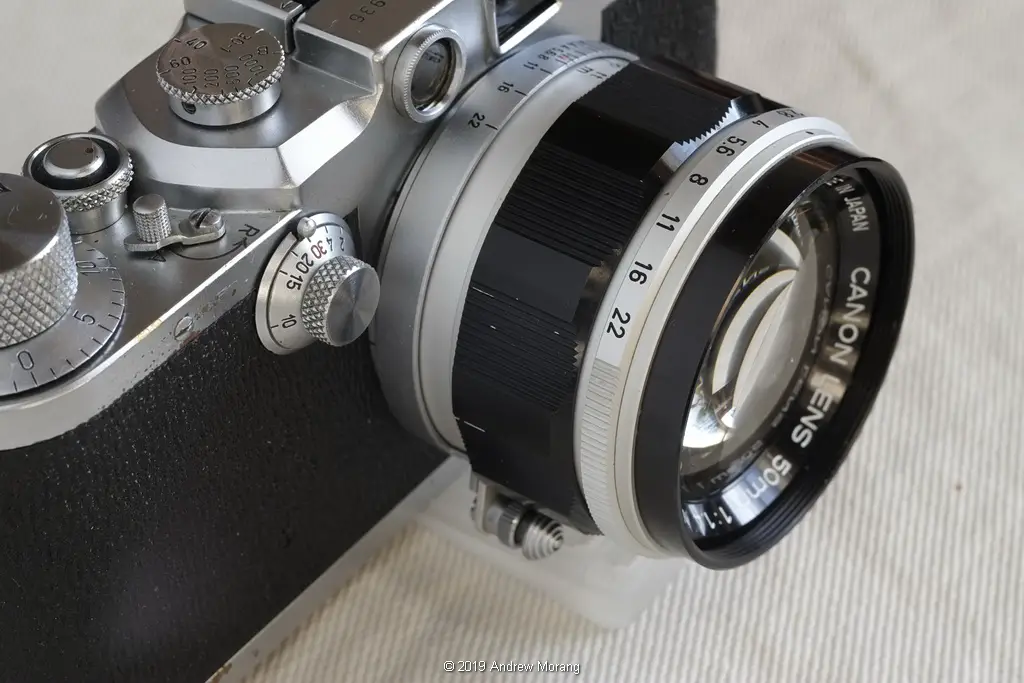
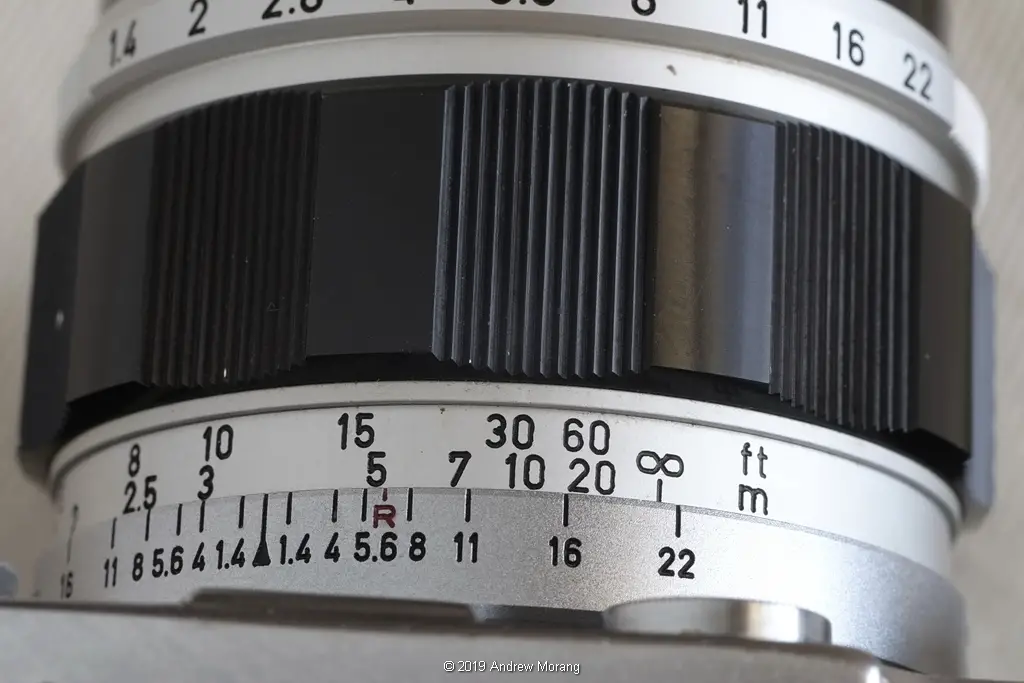
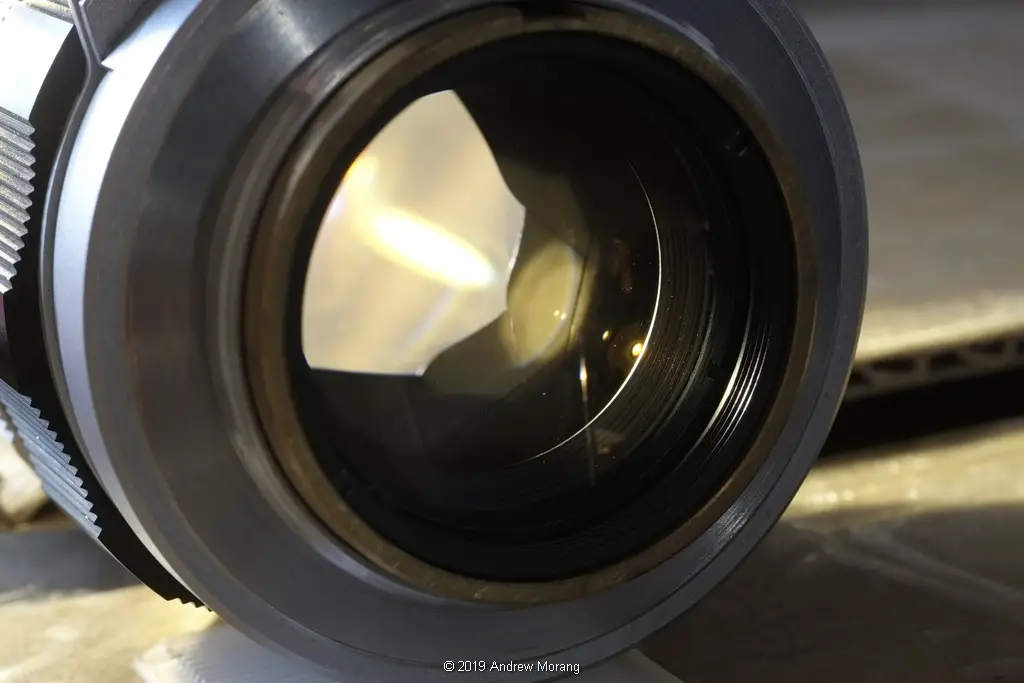
After a bit of searching, I bought this beauty from a Japanese eBay seller. He claimed there were some scratches on the coating, but I cannot see them. The coating is single layer, not multi as in 1970s and newer lenses. Mine is a Type 2, but I do not know the exact date because I have been unable to find a chronology of older Canon lens serial numbers. The lens is a modified Gaussian design with six elements in four groups. The aperture has the modern progression of stops from ƒ/1.4 to ƒ/22 with nice precise clicks. The red R represents the focus adjustment for infrared film. The filter size is 48mm. I ordered a vented hood from one of the Chinese eBay vendors (about $3) as well as some used 48mm filters, and I was ready to take pictures.
Some other reviews of the Canon 50mm ƒ/1.4:
- A blogger, Jason Howe, wrote a detail description of this lens.
- Hamish Gill, the editor of the 35MMC blog, presented nice examples.
- A review by Kevin Shorter.
- Some portraits of Carlos Santana.
It is difficult to tell what the 1.4 lens cost when it was current. A 1963 Modern Photography showed $210. But a 1968 Modern showed only $126.
Examples
When I first received the lens, I mounted it on my Fuji X-E1 digital camera and did some tests to compare with a Leica Summicron, Olympus-OM 50mm Auto-Macro, and a couple other lenses. For a moment, I thought I might show some of the examples here, but that is pixel-peeping for the brick wall and cat whisker “D” crowd. You 35MMC readers deserve real photographs.
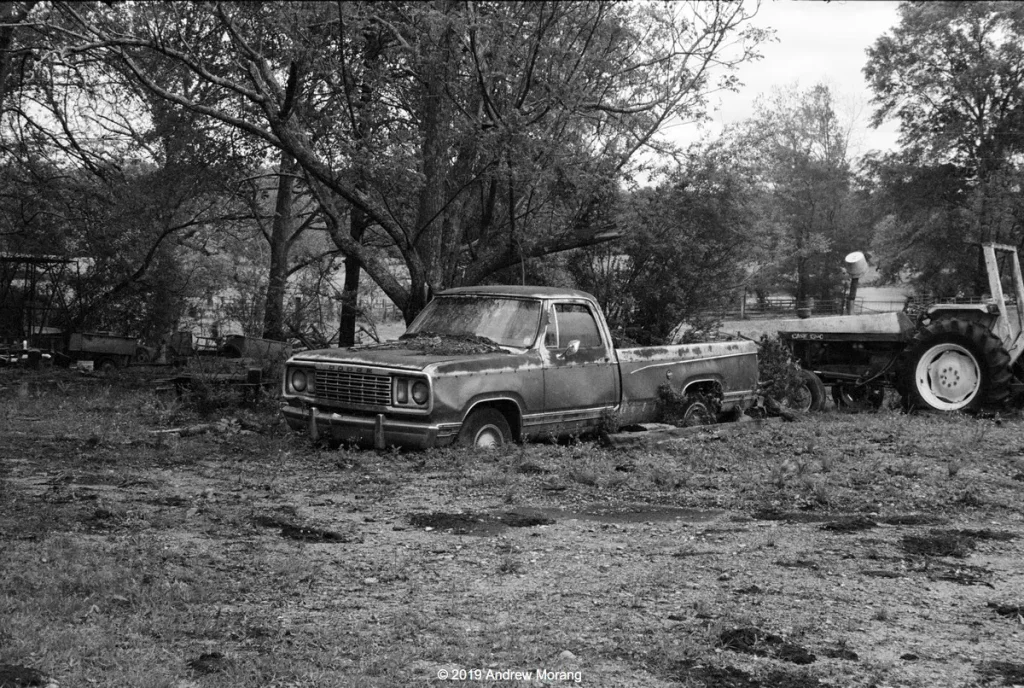
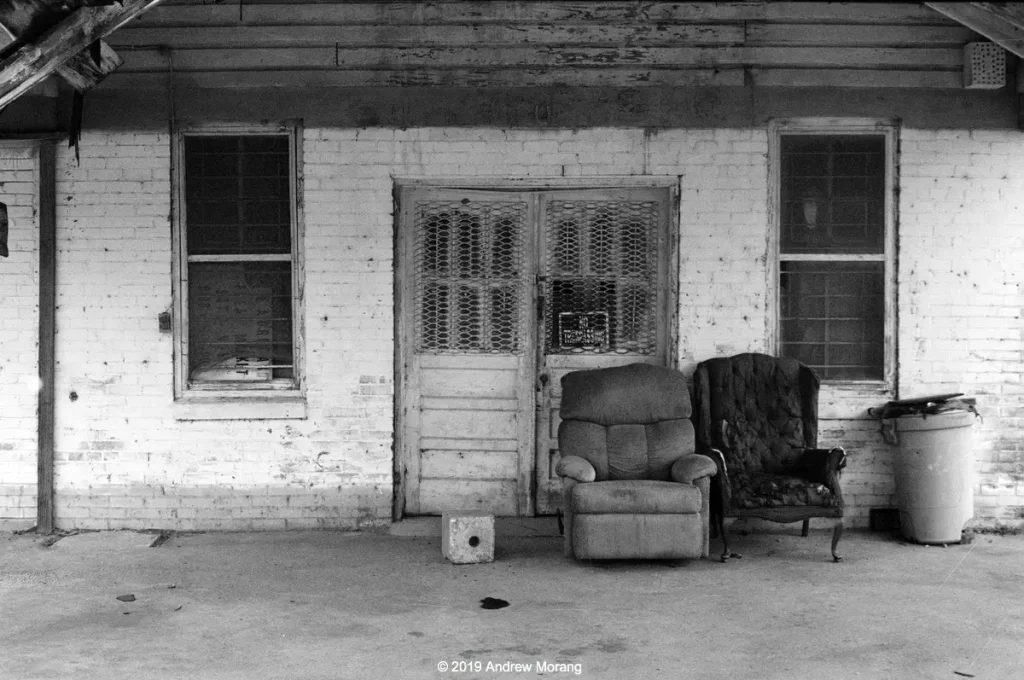
These two frames are from one of my exploration trips south of Jackson in central Mississippi. They are from Kodak BW400CN film, which is a bit grainy but suits the subject matter. I discovered a pinhole in a shutter curtain, but Don Goldberg (DAG Camera) recommended that I touch it up with cloth paint.
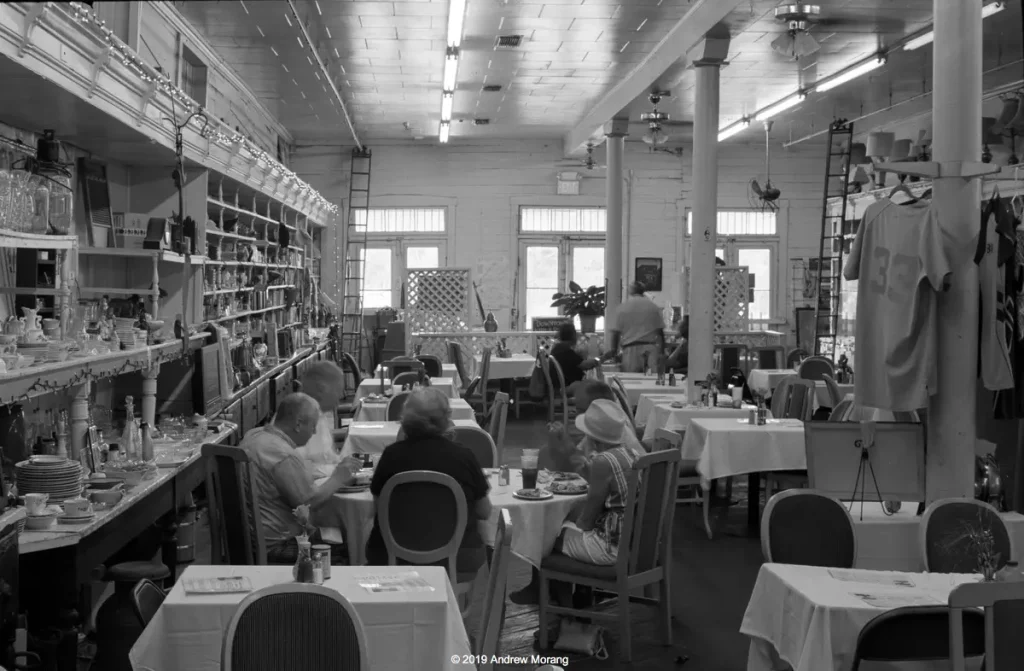
The Old Country Store has been in business in Lorman, Mississippi, since the late-1800s. It is now a restaurant serving quite good southern cuisine. I was pleased to see that the lens did not cause any blooming around the fluorescent lights. Fuji Acros 100 film is superb. I hope the new Acros II is similar.
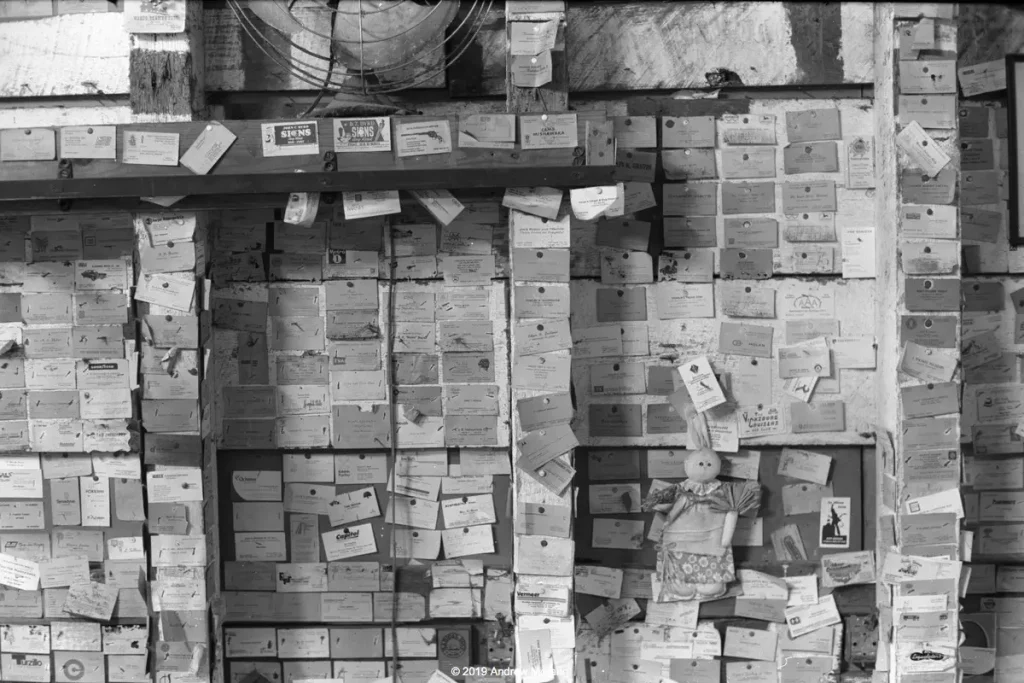
One of the odd quirks of the Old Country Store is the thousands of business cards stapled to the walls. Some have survived since the 1950s.
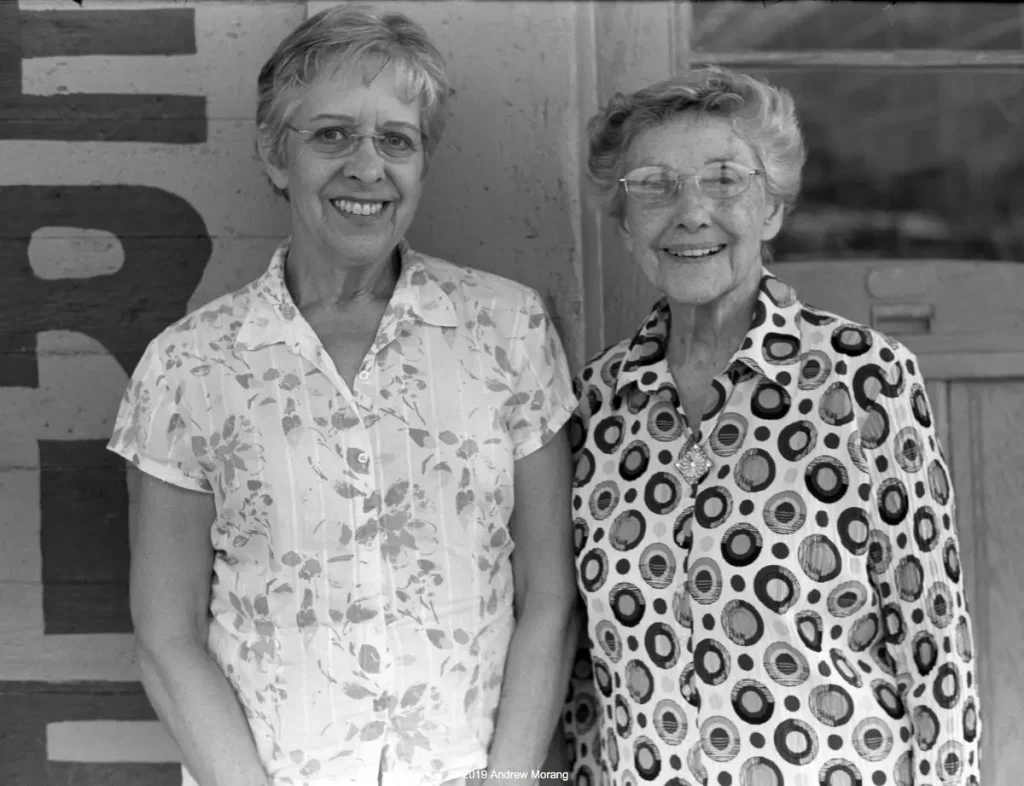
The charming lady on the right grew up in Lorman in the 1930s. She remembers when the store sold seed, farm goods, and tools, and when her uncle brought timber to the railroad siding using oxen.
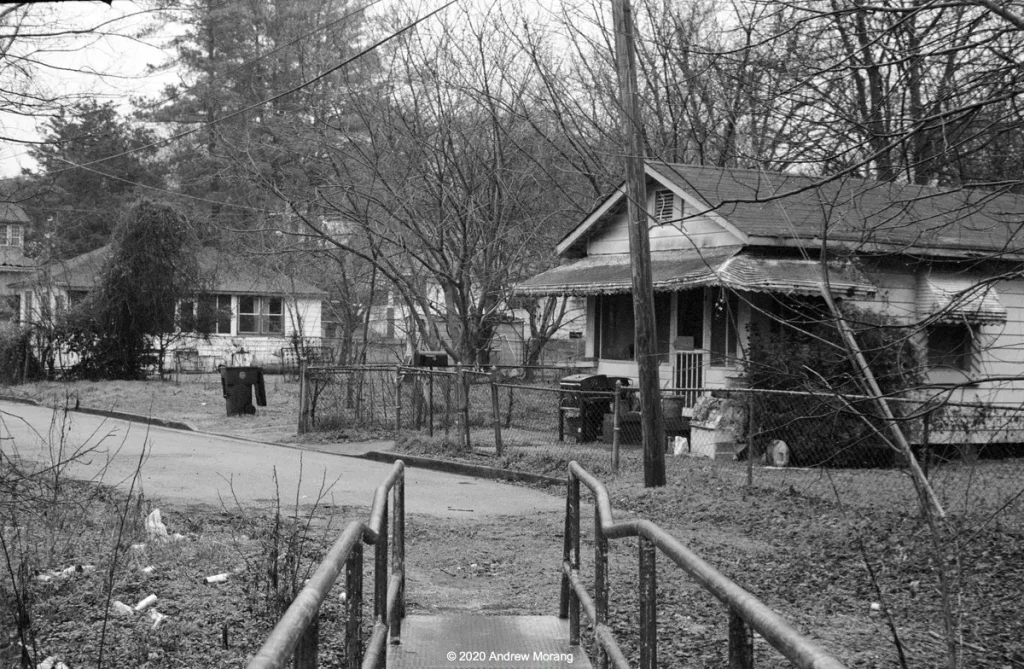
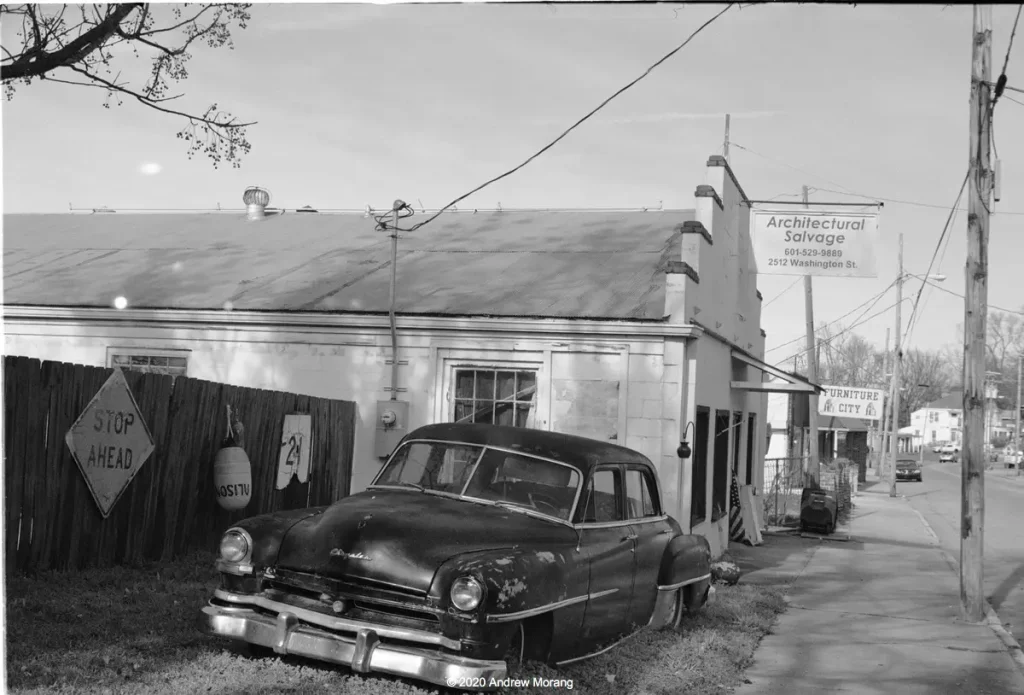
The IIIC is a nice walkaround camera because it is small and quiet. It is a bit smaller than my Leica M2, but I must say, the M2 is faster to operate.
Summary
As you can tell, this is a splendid lens. The focus on my IIIC is correct, the resistance from flare excellent, and the “look” is perfect for my type of photography. At a little over $100, it was an amazing bargain. Here is a summary:
The Good:
- Superb craftsmanship, typical 1960s Japanese optical excellence
- Excellent optical quality
- Easy to find filters at 48mm
- Long throw for focus (which I like)
- Good resistance to flair (see the restaurant photograph above)
- Correct focus for Leica ltm body (no data on Russian ltm bodies)
The Inconvenient
- Rather large and it blocks the view of the Leica’s viewfinder; need an auxiliary 50mm finder.
- Big piece of glass may make the optic susceptible to burning sun pinholes in the shutter curtain. I need to test further because I never experienced this with my 5cm Summitar.
All in all, this is a superb optic. I have no issues with the optical quality or rendering (and no, I wont do the bokeh nonsense). But as you can see, this 1.4 lens is a big cylinder, and when coupled with the auxiliary viewfinder, it rather undoes the elegant compactness of the little Leica body. Therefore, I am not sure how much I will use for travel. Maybe I should go the opposite direction – try a ƒ/3.5 Elmar? Hmmm…..
Share this post:
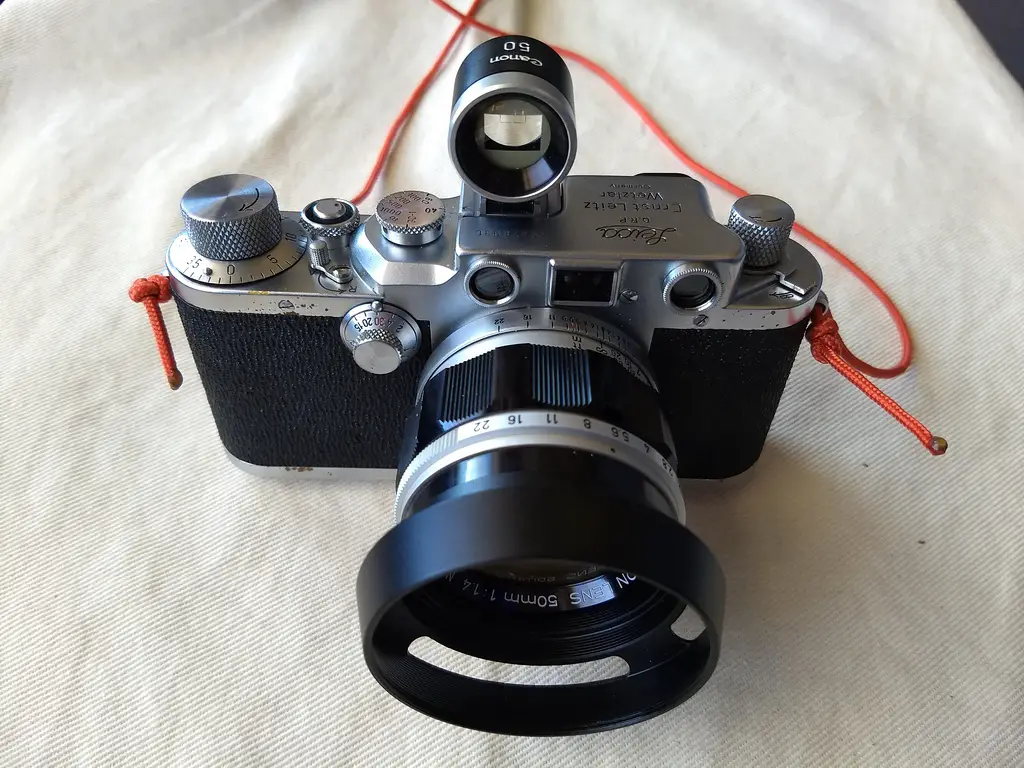








Comments
Steve L New on Canon 50mm ƒ/1.4 LTM Lens – A Mini-Review of 1960s Optical Excellence – by Andrew Morang
Comment posted: 11/03/2020
Comment posted: 11/03/2020
David Hill on Canon 50mm ƒ/1.4 LTM Lens – A Mini-Review of 1960s Optical Excellence – by Andrew Morang
Comment posted: 11/03/2020
Yes it’s a bit large on the iiic body — the 50/1.8 would probably suit better, and the 50/2.2 even more so (both are fine lenses and you can find Hamish’s discussions of both on 35mmc).
From my experience the 1.8’s which have not already succumbed to the haze issue appear to remain in good form. It’s a similar design as the 1.4 (both are 6/4 double gauss) and is also very very fine — referring to my notes again, I find the remark from some reviewer: “Indistinguishable from 50/2 Summicron”. I’m not capable of making that comparison but my personal experience has been very satisfying. It’s typically a bit less expensive than the 1.4 (but the price you quoted for your 1.4 blows that equation out of the water).
The Canon 50/2.2 is quite small and would match well to a iiic body. It’s a bit of a surprise—designed and marketed as an economy lens for the P or 7 in the home market, it’s astonishingly good. Its relatively rare and seems to be popular lately so today’s prices exceed the 1.8.
For the other Canon 50’s —I have no personal experience and refer to my notes again — the 2.8 is an economy design and apparently performs like one; the 1.9 (Serenar) is an older design, a precursor to the 1.8 and is soundly exceeded by that; the 1.2 is big and fast and has some fine qualities but loses the technical excellence of the 1.4/1.8 in its quest for speed. The 0.95 is rare and expensive and in a class apart: like the 1.2 but more so: it’s huge and fast and dreamy, but it’s not LTM — it only mounts to the external bayonet mount added to the Canon 7. I’ve seen a few M-mount conversions, but beware—some of those are TV camera versions and lack rangefinder coupling.
bwf on Canon 50mm ƒ/1.4 LTM Lens – A Mini-Review of 1960s Optical Excellence – by Andrew Morang
Comment posted: 11/03/2020
Roger B. on Canon 50mm ƒ/1.4 LTM Lens – A Mini-Review of 1960s Optical Excellence – by Andrew Morang
Comment posted: 11/03/2020
Graham Orbell on Canon 50mm ƒ/1.4 LTM Lens – A Mini-Review of 1960s Optical Excellence – by Andrew Morang
Comment posted: 11/03/2020
Comment posted: 11/03/2020
Graham Orbell on Canon 50mm ƒ/1.4 LTM Lens – A Mini-Review of 1960s Optical Excellence – by Andrew Morang
Comment posted: 11/03/2020
Comment posted: 11/03/2020
Jonathan Leavitt on Canon 50mm ƒ/1.4 LTM Lens – A Mini-Review of 1960s Optical Excellence – by Andrew Morang
Comment posted: 11/03/2020
Brian on Canon 50mm ƒ/1.4 LTM Lens – A Mini-Review of 1960s Optical Excellence – by Andrew Morang
Comment posted: 11/03/2020
When getting any of the Canon Black lenses- best to have a return privilege.
Took me 3 tries for an F1.2:
https://cameraderie.org/threads/canon-50-1-2-in-leica-thread-mount.37767/
Even more tries for the 50/1.8,
https://cameraderie.org/threads/canon-50mm-f1-8-later-black-version.49830/
Took the F1.4 and F1.2 to a Museum for some comparisons.
https://cameraderie.org/threads/canon-50mm-f-1-4-ltm.37719/#post-369266
Prices on the Canon 50/1.4 are way down- half of what they were 15 years ago. They are a bargain.
Comment posted: 11/03/2020
Pham Anh on Canon 50mm ƒ/1.4 LTM Lens – A Mini-Review of 1960s Optical Excellence – by Andrew Morang
Comment posted: 12/03/2020
Comment posted: 12/03/2020
Alvaro on Canon 50mm ƒ/1.4 LTM Lens – A Mini-Review of 1960s Optical Excellence – by Andrew Morang
Comment posted: 14/03/2020
Comment posted: 14/03/2020
5 Frames with a 35mm Summicron-R Lens at the Botanical Garden – by Christian Schroeder - 35mmc on Canon 50mm ƒ/1.4 LTM Lens – A Mini-Review of 1960s Optical Excellence – by Andrew Morang
Comment posted: 18/04/2020
Seppo H on Canon 50mm ƒ/1.4 LTM Lens – A Mini-Review of 1960s Optical Excellence – by Andrew Morang
Comment posted: 08/08/2020
I have a nice copy of the 50/1.4, and like it a lot.
Daniel Castelli on Canon 50mm ƒ/1.4 LTM Lens – A Mini-Review of 1960s Optical Excellence – by Andrew Morang
Comment posted: 26/05/2021
This is a belated posting, but I purchased a Canon f/1.4 LTM (w/a LTM to M adapter) for around $400.00 off of eBay about two months ago. I used your review and other articles on the Canon lens posted on 35MMC to help me make my decision. Its everything you described.
Originally, my plan was to get a 1.4 lens in the 50mm length as a 'sometimes' lens. Cost was a huge factor; even early copies of Summilux lenses command high prices. Tough to justify as I'm happily retired and want to stay that way. I've never warmed up to the Voigtlander 50mm f/1.5. I had one for a bit, but we never bonded. The Canon was the logical choice. I'm happy with my copy. It had been CLA - glass is bright and clear. Only quibble is the aperture ring is a bit stiff to rotate. I'll send it out to be tweaked in the near future. I process my own B&W film and the results with this lens are a classic rendering in the style of the 1960's.
Another plus found in buying this lens is that if I get bit by the bug to get a IIIG, I can use this lens on the camera. That though is appealing.
Again, thanks to you & other contributors to 35MMC AND Hamish for the informative articles.
-Dan
Comment posted: 26/05/2021
Agata Urbaniak on Canon 50mm ƒ/1.4 LTM Lens – A Mini-Review of 1960s Optical Excellence – by Andrew Morang
Comment posted: 13/02/2022
Comment posted: 13/02/2022